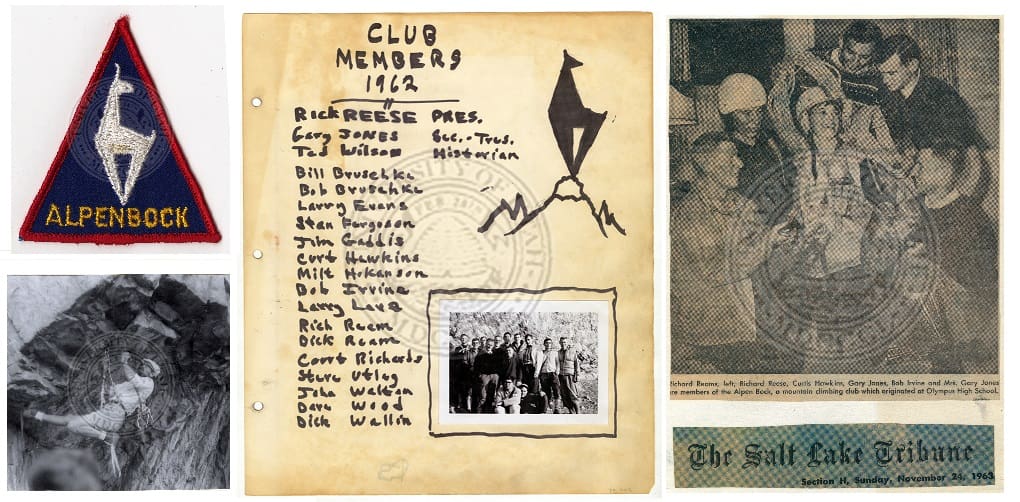Story by Maya Gans /
Whether beginning the strenuous four hour approach to Lone Peak Cirque, or heading up to Catherine’s Pass to finally tick off Seth’s Arete for some after-work bouldering, you can hear the battle cry of approaching climbers: “Almost there!”
I can find meditation in the slow and steady trudging up a well-worn approach trail with double trad rack and rope, but recently, the trance of one foot in front of the other was broken with the realization that weaving around thorny bushes and poison oak on established trails is something I tend to take for granted. Combining this moment of gravel-grinding gratitude with news of LCC’s new Alpenbock Loop Trail, I found it fitting to explore yet another Innovation in Climbing: The Climbing Trail.
In 1965, Curtis Hawkins wrote an article entitled “Cliff Clingers” for the Salt Lake City Tribune. Hawkins describes the newly-formed Alpenbock (Mountain Goat) club as 12 ambitious, local Salt Lake City climbers with “a sense of adventure combined with the kind of common sense it takes to get the kind of know-how that can keep you safe while climbing.” The club’s original members ambitiously and enthusiastically put up new lines in both Big and Little Cottonwood Canyons and were the first to explore its boulders. Rather than philosophical musings on “why we climb,” the article reads like a recruiting advertisement focusing on the skills needed to become a club member, with a final test on “The Rock,” a small outcropping on Wasatch Boulevard now known as Pete’s Rock. The article closes with: “Our best climber, Bob Stout… made a beautiful descent over a breathtaking overhang – and then tripped over a cactus plant after he was down and got a bloody nose!” As early as the 1960s, Alpenbock Club members made many bold first ascents, and by 1965 the club began proposing volunteer efforts to Salt Lake County Commissioner John Preston Creek, asking for permission to build trails. In fact, founding member Ted Wilson went on to become Salt Lake’s mayor in 1976, and as an outdoorsman, always advocated for the environment. The Alpenbock club has since dissolved, but Wilson is an active advisor to the Board of Directors for the Salt Lake Climbers Alliance, and while he’s climbed all over the world, LCC remains the place of his “heart and soul.”
In 2001, the Forest Service reached out to Nathan Smith, the Access Fund’s Regional Coordinator at the time, to discuss a climbing access issue in Big Cottonwood Canyon. Smith put together an informal public meeting with the Forest Service to discuss the climbing access to Storm Mountain Picnic Area. The local climbers who attended the meeting were inspired to continue to meet, forming a local climbing organization. At subsequent meetings, the original board members of the Salt Lake Climbers Alliance (SLCA) were elected in early 2002.
Julia Geisler, the current SLCA Executive Director, explained, “Traditionally climbers have approached the crag in the most direct fashion possible, often resulting in highly eroded approach trails. This combined with decades of climbers never going the same way twice to access the crags via a multiple bush-crashing spider-webbed trail approach starts to have a real impact on the environment.” Classic routes along the Alpenbock Trail like Bongeater, The Coffin, and Mexican Crack were put up in the 1950s and 60s by The Lowes, a powerhouse consisting of Jeff, Greg, and unrelated George Lowe. These routes were futuristic at the time, pushing climbing grades and climbers themselves to become stronger and braver. As the area garnered popularity, traffic would create a spiderweb of trails. A focal point of the SLCA is to reduce the climber’s impact to the forest by aligning braided trails into a single approach by consolidating trails and using appropriate signage.
Ty Tyler is the current Access Fund Stewardship Director, with the role of planning, organizing, funding and implementing the variety of infrastructure projects at climbing areas. Tyler explained the rigor and detail needed to see a project like the Alpenbock Loop Trail from start to finish.
The first, and perhaps most important step that goes into building a climbing access trail is to join local and national climbing organizations that build relationships with the land manager, whether it’s the BLM, National Park Service, National Forest Service, a state park, or US Fish and Wildlife Service. Only by working with these government agencies is it possible to have a shared vision of the area, and by having representatives present at local efforts like Adopt-a-Crag the officials see that although the climbing community is relatively small, we are passionate and care about our access. When you’re volunteering your efforts are then two-fold: you’re directly aiding in the maintenance of a crag, but can also later be used as a datapoint for the land managers if future access issues arise — “See? Climbers not only use the area, but take care of it as well!” In addition, volunteer hours can help to bring funds to Forest Service land in the form of grants.
Once that relationship is in place, a map and project proposal are compiled to present to the land agency. The proposal must comply with the National Environmental Policy Act (NEPA) to ensure the route won’t affect cultural or ecological resources. This report may include an Environmental Impact Statement, Environmental Assessment, and Categorical Exclusions. The proposal is overlooked by many “-ologists” like biologists, hydrologists, and archaeologists, and can become a final draft after reviewal with a public comment period. Locally, the SLCA plays a big role in gathering data including impact assessments and project proposals that can be used by land agencies should the project go through NEPA.
Climber trails are often different from hiking trails in that climbers tend to be averse to long switchbacking trails, preferring steeper and shorter approaches. However, projects on public lands must serve the public in the most holistic sense–not solely the climbing community. Keeping this in mind when constructing the Alpenbock Loop, the SLCA and AF among many other organizations hardened existing climbing trails into a network that both efficiently accesses classic climbs and serves as a beautiful hiking loop for other recreationalists.
The crews and work that go into trail building and restoration can be costly, so once the proposal fully complies with NEPA, grant applications and public-private partnerships must be formed to implement the work. In the creation of the Alpenbock Loop, the SLCA was instrumental in finding grant money through state, federal, and local sources, and identifying partners whose skills and materials they could leverage. After funding and partnerships are in place, volunteers and professional trail crews join together with shovels, macleods, and brush saws to clear a defined trail and trudge boulders in wheelbarrows to create rock steps where necessary. By involving the local climbing community, it can be assured that the trail will be maintained into the future and volunteer hours match grant dollars.
So, the next time you’re thinking “Are we there yet?” while scrambling up a scree field, take a moment to appreciate the cairns and signs marking your path, and remember you’re doing your part by using the established trail. As climbers, we can choose our level of community involvement, but when you’re checking out the new Alpenbock Loop, keep in mind it is a privilege that the bush-wacking Alpenbock Club members of the 1960s did not have. Ted Wilson put up LCC’s first route, Chickenhead Holiday at a time when climbers thought the granite slabs would be impossible to summit. Today, as long as the weather is nice, many climbers enjoy LCC’s slabs and cracks. Wilson recently said, “When I was growing up we had space, security, and freedom. It was a sweet spot in history, and I want to work to keep part of that available for kids growing up today.” The new Alpenbock Loop Trail is a physical manifestation of that vision––now go out and enjoy it!
Further Reading:
Join and Learn about the Access Fund


